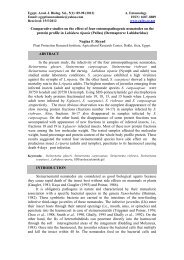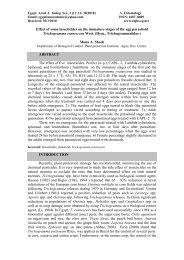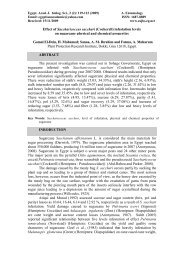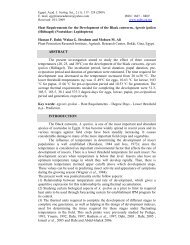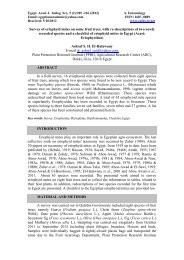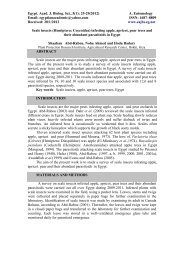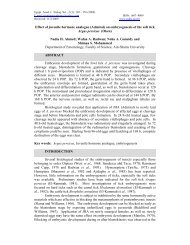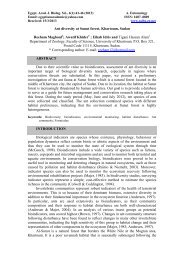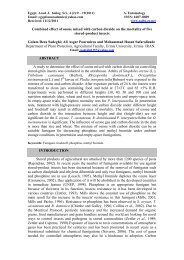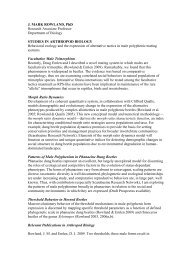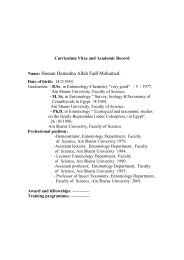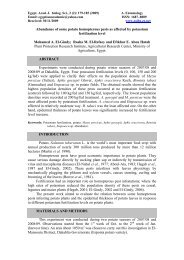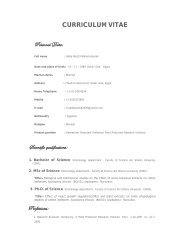Relationship between temperature and some biological aspects and ...
Relationship between temperature and some biological aspects and ...
Relationship between temperature and some biological aspects and ...
You also want an ePaper? Increase the reach of your titles
YUMPU automatically turns print PDFs into web optimized ePapers that Google loves.
Egypt. Acad. J. Biolog. Sci., 6(1): 11-20 (2013) A. Entomology<br />
Email: egyptianacademic@yahoo.com ISSN: 1687–8809<br />
Received: 15/1/2013 www.eajbs.eg.net<br />
<strong>Relationship</strong> <strong>between</strong> <strong>temperature</strong> <strong>and</strong> <strong>some</strong> <strong>biological</strong> <strong>aspects</strong> <strong>and</strong> biochemical<br />
of Earias insulana (Boisd.) (Lepidoptera: noctuidae)<br />
K<strong>and</strong>il Mervat A. A.<br />
Plant Protection Research Institute, Agriculture Research Center, Dokki- Giza, Egypt<br />
ABSTRACT<br />
The experiments were carried out under controlled conditions of <strong>temperature</strong>s<br />
(16, 21, 26, 32 <strong>and</strong> 37 ± 1ºC) <strong>and</strong> relative humidity 65-70 % R.H. to study the<br />
<strong>temperature</strong> effect on <strong>some</strong> <strong>biological</strong> <strong>aspects</strong> <strong>and</strong> biochemical of Earias insulana<br />
field strain when reared on okra pods. The incubation period of E. insulana eggs was<br />
12.45 days at 16ºC. But on 37 ºC it shortened to 1.10 days. Larval duration decreased<br />
as <strong>temperature</strong> increased when reared on okra pods. Similar trend was recorded for<br />
pupal duration. Generation period lasted 38.27 days on 21 ºC but it shortened to 17.4<br />
days on 32 ºC. The thresholds of development (To) were 15.95, 14.41, 13.32, 17.63<br />
<strong>and</strong> 12.85 ºC for eggs, larvae, pupae, pre- oviposition <strong>and</strong> generation period of E.<br />
insulana, respectively. While, the average of thermal units required to complete the<br />
developmental stages were 23.15, 131.33, 90.79, 20.83 <strong>and</strong> 346.19 DD̉ s, respectively,<br />
when reared on okra pods. The total eggs laid by female high significantly affected by<br />
all <strong>temperature</strong>s. The highest number of eggs laid at 26 followed by 21ºC binge<br />
273.66 <strong>and</strong> 208.00 eggs/female. The low <strong>and</strong> high <strong>temperature</strong>s caused the highest<br />
reduction in total lipid <strong>and</strong> protein. The reduction in total lipid <strong>and</strong> protein caused<br />
reduction in the fecundity <strong>and</strong> fertility of E. insulana adult female.<br />
Key words: Earias insulana (Boisd.), <strong>temperature</strong>, development <strong>and</strong> Biochemical<br />
INTRODUCTION<br />
The spiny bollworm (SBW), Earias insulana (Lepidoptera: Noctuidae) is one of<br />
the most dangerous pests attacking many plants of Malvaceae family, especially okra<br />
Abelmos esculentaus. It's one of the most important vegetable crops growing during<br />
the summer <strong>and</strong> kharif seasons. However under field conditions, constant<br />
<strong>temperature</strong>s are not maintained for along period <strong>and</strong> fluctuating <strong>temperature</strong>s can<br />
cause difference in development <strong>and</strong> survival (Nowierski et al., 1983; Liu <strong>and</strong> Meng,<br />
1999 <strong>and</strong> Davis et al., 2006). Temperature is critical a biotic important factor<br />
affecting the seasonal fluctuation <strong>and</strong> population dynamics of this pest on different<br />
host plant in the field (Hoffmann et al., 2003 <strong>and</strong> Tran et al., 2007). Temperature<br />
determines the likelihood of mortality <strong>and</strong> hence, population declines, especially at<br />
extremes (Chown <strong>and</strong> Terblanche, 2007).<br />
Many authors recorded that relationship <strong>between</strong> the <strong>temperature</strong>s <strong>and</strong> many<br />
<strong>aspects</strong> of <strong>biological</strong> processes (Al-Mohammady, 2000 <strong>and</strong> Dhillon <strong>and</strong> Sharma,<br />
2004). Ismail et al., (2005) <strong>and</strong> Shah et al., (2012) studied the effect of <strong>temperature</strong> on<br />
developmental times of the life history stage of the E. insulana <strong>and</strong>/ or Earias vittella.<br />
They recorded the low <strong>temperature</strong>s from 15 to 20 ºC caused prolonged larvae <strong>and</strong><br />
pupal stages, increased the mortality, While the high <strong>temperature</strong> from 31 to 35 ºC the<br />
development of larvae was faster. The high rate of pupation failure suffered by fastgrowing<br />
insects at 34 ºC (Shah et al., 2012). On the other h<strong>and</strong>, considering the<br />
optimum <strong>temperature</strong> ranged from 25 to 28 ºC, because the all stages can be
12<br />
K<strong>and</strong>il Mervat A. A.<br />
completed the development <strong>and</strong> eggs produced, reproductive was much higher at 27<br />
ºC compared to 20 ºC (Czesak <strong>and</strong> Fox, 2003 <strong>and</strong> Fayez, 2011).<br />
Also, effect of <strong>temperature</strong> on biochemistry, physiology, behavior <strong>and</strong> lifehistory<br />
traits studied by (Kingsolver, et al., 2004). Developmental processes are<br />
controlled by <strong>temperature</strong> dependent on biochemical reactions, which are restricted by<br />
lower <strong>and</strong> upper thresholds (Sharpe <strong>and</strong> Demichele, 1977; Hochachka <strong>and</strong> Somero,<br />
2002 <strong>and</strong> Domos <strong>and</strong> Soultani, 2008).<br />
The objectives of the current study were to investigate the effect of<br />
constant <strong>temperature</strong>s <strong>and</strong> fed on okra pods on <strong>some</strong> <strong>biological</strong> <strong>aspects</strong> <strong>and</strong><br />
biochemical of Earias insulana in order to determine the optimum <strong>temperature</strong>.<br />
MATERIALS AND METHODS<br />
The experiments were carried out to study the effect of different constant<br />
<strong>temperature</strong>s (16, 21, 26, 32 <strong>and</strong> 37 ± 1°C) <strong>and</strong> 65-70 % R.H. on <strong>some</strong> <strong>biological</strong><br />
<strong>aspects</strong> <strong>and</strong> biochemical of E. insulana when fed on okra pods.<br />
1- Insect used:<br />
The spiny bollworm, E. insulana:<br />
Full grown larvae of E. insulana used in the currant study was collected from<br />
okra field at Sharkia Governorate during September to November of 2011 season <strong>and</strong><br />
transferred to Bollworm Research Department, Plant Protection Research Institute,<br />
Agricultural Research Centre (ARC).<br />
Insect rearing<br />
The SBW larvae collected from okra fields were fed separately on okra pods in<br />
glass tubes (3 × 10 cm) covered with absorbent cotton wool. The food was daily<br />
renewed until pupation. Pupae were transferred to clean glass tubes <strong>and</strong> incubated<br />
until moth emergence. The emerged moths were sexed <strong>and</strong> caged to eggs lay. Moths<br />
were provided with 10 % honey solution. The eggs were separated daily <strong>and</strong> placed in<br />
glass jars. Obtained eggs were used in experiments.<br />
Development of different stages:<br />
Eggs laid on the same day (< 24 old) were placed in glass jar <strong>and</strong> incubated<br />
under five constant <strong>temperature</strong>s (16, 21, 26, 32 <strong>and</strong> 37± 1°C) <strong>and</strong> 65-70% R.H.<br />
Three replicates of 100 eggs/each were used for each tested <strong>temperature</strong> degree. The<br />
number of eggs hatched was recorded <strong>and</strong> eggs incubation period was calculated. The<br />
hatched larvae in each <strong>temperature</strong> were used for studied the developmental at the<br />
respective <strong>temperature</strong>.<br />
Newly hatched larvae were transferred individually to glass tubes (3 × 10 cm)<br />
containing cutting okra pod (about ½ okra pod), <strong>and</strong> changed with fresh anther every<br />
one day. Each tube was plugged tightly with absorbent cotton <strong>and</strong> placed in an<br />
incubator at the previous conditions. Four replicates of 40 larvae/ each were used for<br />
each tested <strong>temperature</strong>. Larvae were examined daily until pupation to record larval<br />
duration. Pupae were transferred to clean glass tubes <strong>and</strong> examined daily until moth<br />
emergence to record pupal duration. The weight of full grown larvae <strong>and</strong> pupal were<br />
recorded. When adults emerged, moths were sexed <strong>and</strong> caged to eggs laying. Moths<br />
were provided with 10 % honey solution. The cages were inspected daily until moth<br />
death. The pre-ovipostion, oviposition <strong>and</strong> post-ovipostion periods <strong>and</strong> longevity of<br />
adult females <strong>and</strong> males <strong>and</strong> the numbers of eggs <strong>and</strong> hatchability percentages were<br />
calculated.
<strong>Relationship</strong> <strong>between</strong> <strong>temperature</strong> <strong>and</strong> <strong>some</strong> <strong>biological</strong> <strong>aspects</strong> <strong>and</strong> biochemical of E. insulana 13<br />
Statistical analysis<br />
One way analysis of variance (ANOVA) <strong>and</strong> Duncan's multiple range test of<br />
means were used (Duncan's, (1957).<br />
Effect of different constant <strong>temperature</strong>s on different stages of E. insulana.<br />
Data recorded in the present work were analyzed by simple regression analysis.<br />
The effects of the above mentioned conditions were tested on eggs, larvae, pupae <strong>and</strong><br />
pre- oviposition period of E. insulana after rearing on okra. Except rat of SBW´s<br />
development at 16 <strong>and</strong> 37°C not included in our analysis because the adults<br />
emergence were very few number. The theoretical development thresholds <strong>and</strong> the<br />
thermal units required were determined according to Blunk (1923) as following:<br />
(y) = a + bx<br />
Y = rate of development = 1/ duration, a= constant <strong>temperature</strong>. <strong>and</strong> b =<br />
simple regression coefficient<br />
T0= - a/b <strong>and</strong> k = 1/b<br />
T0 estimated thermal units required to complete development of each stage,<br />
equation of thermal summation was used according to Blunk (1923).<br />
K = y (T – T0).<br />
K = Thermal units (degree days = DDs); y = duration (days); T0 = threshold of<br />
development; T = <strong>temperature</strong> in degree centigrade used.<br />
Biochemical analysis:<br />
To study the effect of <strong>temperature</strong> on <strong>some</strong> biochemical parameters, 100 newly<br />
hatched larvae of SBW transferred individually to glass tubes (3X 10 cm) containing<br />
okra pods <strong>and</strong> kept under the previous controlled conditions. The samples of SBW<br />
larvae were collected after 20 days at 16 ºC, ten days at 21 <strong>and</strong> 26 ºC <strong>and</strong> 4 days at<br />
32 <strong>and</strong> 37 ºC <strong>and</strong> kept in clean tubes in a refrigerator at 4 ºC for chemical analysis.<br />
Determination of Biochemical parameters:<br />
Total protein, total lipids, glucose <strong>and</strong> amylase, glutamic oxaloacetic<br />
transaminase (GOT = ALT) <strong>and</strong> glutamic pyruvic transaminase (GPT = AST) enzyme<br />
activities were determined colorimetrically according to Koller (1984), Drevon <strong>and</strong><br />
Schmitt (1964), Henry <strong>and</strong> Chiamori (1960); Trinder (1969) <strong>and</strong> Murray (1984).<br />
RESULTS AND DISCUSSIONS<br />
Effect of <strong>temperature</strong> on different stages of E. insulana:<br />
Egg hatchability:<br />
Data presented in Table (1) <strong>and</strong> Fig (1) Showed that the E. insulana eggs was<br />
able to hatch at range of <strong>temperature</strong>s from 16 - 37ºC, but the highest hatchability was<br />
recorded at 26 flowed by 21 ºC. The reduction of hatchability at high <strong>temperature</strong> may<br />
be due to an adverse affect of high <strong>temperature</strong> on embryonic development.<br />
Percentage of larval <strong>and</strong> pupal mortality:<br />
Data presented in Table (1) <strong>and</strong> Fig (1) reveled that the high percentage of mortality<br />
recorded at 16, 32 <strong>and</strong> 37 ºC. The respective, mortalities were 37, 46 <strong>and</strong> 69 %. On<br />
the other h<strong>and</strong>, the pupal mortality was 82.9 % at 16 ºC <strong>and</strong> 93 % at 37 ºC. These<br />
resulted agree with Dooremalen, et al. (2011) recorded that the high <strong>temperature</strong><br />
cause 50 <strong>and</strong> 90% mortality in both sexed adults.<br />
Larval <strong>and</strong> pupal weight:<br />
The average larval <strong>and</strong> pupal weights of SBW were high decreased to 0.004<br />
<strong>and</strong> 0.003 g/ larva <strong>and</strong> 0.003 <strong>and</strong> 0.001 g/pupae at 16 <strong>and</strong> 37 ºC, respectively, while it<br />
was increased to 0.066 g/ larva <strong>and</strong> 0.043g/ pupa at 26 ºC. From these data can be<br />
concluded that the low <strong>and</strong> high <strong>temperature</strong> caused high reduction in weight larvae
14<br />
K<strong>and</strong>il Mervat A. A.<br />
<strong>and</strong> pupae from 21 to 22 time which lead to small in body size <strong>and</strong> caused failure in<br />
adult's emergence (Table, 1).<br />
Lee <strong>and</strong> Roh (2010) observed that the main cause of mortality for larvae of<br />
Spodoptera exigua at 34 ºC was developmental failure during the process of the pupal<br />
metamorphosis. Nijhout (1994) Recorded that high rate of pupation failure suffered<br />
by fast-growing insects at 34 ºC could be due to greater of energy limitation during<br />
this critical, energy-dem<strong>and</strong>ing stage.<br />
Percentage of adult emergence:<br />
Data presented in Table (1) & illustrated in Fig. (1) clearly the high reduction<br />
in adult emergence to 17 <strong>and</strong> 7 % at 16 <strong>and</strong> 37 ºC, respectively, while, the average<br />
percent of adult emergence increased to 91% at 26ºC .<br />
Table 1: Effect of <strong>temperature</strong> on different stages of E. insulana<br />
Temp.<br />
ºC<br />
No.<br />
used<br />
Eggs No. of<br />
larvae<br />
used<br />
Larval stage Pupal stage<br />
% adult<br />
emergence<br />
Hatchability%<br />
Mortality Weight<br />
% (g)<br />
Pupation<br />
%<br />
Weight<br />
(g)<br />
Mortality<br />
%<br />
16 300 54.00 160 37.00 0.004 63.00 0.003 82.9 17.10<br />
21 300 89.90 160 21.00 0.048 79.00 0.029 37 63.00<br />
26 300 93.00 160 8.00 0.066 88.00 0.043 8.9 91.10<br />
32 300 83.10 160 46.00 0.006 73.00 0.002 63 37.00<br />
37 300 53.60 140 69.00 0.003 17.00 0.001 93 7.00<br />
100<br />
90<br />
80<br />
70<br />
60<br />
50<br />
40<br />
30<br />
20<br />
10<br />
0<br />
hatchability larval mortality Pupation % pupal mortality % adult emergence<br />
16 21 26<br />
<strong>temperature</strong>s<br />
32 37<br />
Fig. 1: Effect of <strong>temperature</strong> on different stages of E. insulana<br />
Effect of <strong>temperature</strong> on developmental periods of E. insulana:<br />
Incubation eggs:<br />
Data in Table (2) recorded that the incubation period of E. insulana eggs was<br />
12.45 days when reared on okra at 16ºC, while on 37 ºC they shortened to 1.10 days.<br />
Significant differences were found <strong>between</strong> the incubation periods of eggs as related<br />
to <strong>temperature</strong>, it indicated that embryonic development of the E. insulana was<br />
affected with tested <strong>temperature</strong>s. The threshold development (T0) of eggs was 15.95<br />
ºC while the average degree days (DD̉ s) required for complete development was<br />
23.15 DD̉ s on okra pods. This resulted agreement with Al- Mohammady (2000)<br />
reported the lowest incubation period of Earias vettella ranged from 2 -1.15 days on<br />
32.6 ºC <strong>and</strong> highest incubation period 3- 5 days on 23.2 ºC. (Shah et al. (2011)<br />
recorded that the lowest incubation period for E. vittella was 2 days on 35 ºC <strong>and</strong> the<br />
highest 4 days on 27 ºC.
<strong>Relationship</strong> <strong>between</strong> <strong>temperature</strong> <strong>and</strong> <strong>some</strong> <strong>biological</strong> <strong>aspects</strong> <strong>and</strong> biochemical of E. insulana 15<br />
Table 2: Duration, rat of developmental (RD), developmental threshold (T0) <strong>and</strong> degree day (DD̉ s) for<br />
E. insulan.<br />
Duration <strong>and</strong> rat of developmental period of E. insulana:<br />
Larval stage:<br />
At 16, 21, 26, 32 <strong>and</strong> 37 ºC, the average durations were 45.56, 19.3, 13.7, 8.26<br />
<strong>and</strong> 5.3 days, respectively, for E. insulana larvae reared on okra pods. Statistical<br />
analysis showed significant negative deference <strong>between</strong> the mean of larval durations<br />
<strong>and</strong> all tested <strong>temperature</strong>s. The correlation coefficient values (r = -0.89, R 2 = 0.042,<br />
P< 0.05), Table (2). The lower threshold of development (T0) for the larval stage was<br />
14.41 ºC. The average thermal unite required for larval development till pupation was<br />
131.33 DD̉̀ s. Can be concluded that at 16˚C development was much slower than other<br />
<strong>temperature</strong>s it tacked 8.58 time than the larvae reared at 37 ºC. The developmental<br />
period of SBW larvae was decreased as <strong>temperature</strong> increased. This resulted agree<br />
with Al- Mohammady (2000) reported that the larval durations were 5 <strong>and</strong> 12 days of<br />
E. vitttella reared at 31 <strong>and</strong> 27 ºC, respectively. Dhillon <strong>and</strong> Sharma (2004) observed<br />
that the E. vittella larval period was ranged <strong>between</strong> 9.2 – 12.2 days at 28 ºC, Fayez<br />
(2011) reported that the mean larval duration was 3.54 days at 33 ºC <strong>and</strong> 14.7 days at<br />
26 ºC for E. insulana.<br />
Pupal duration:<br />
As shown in Table (2) the pupal duration of E. insulana decreased as<br />
<strong>temperature</strong> increased from 16 to 37 ºC. The average durations were 20.00 days on<br />
16°C <strong>and</strong> 3.27 days at 37˚C, respectively. Can be concluded that high <strong>temperature</strong><br />
reduced duration to 6.10 time at 37 ºC compared to 16 ˚C. The developmental<br />
threshold (T0) for the pupal stage was 13.32 ºC <strong>and</strong> the average of thermal heat units<br />
required was 90.79 DD̉̀ s for E. insulana pupae completed developmental period.<br />
Pre- oviposition period:<br />
Data presented in Table (2) recorded that the mean of pre- oviposition period<br />
was 1.37 days at 32 ºC <strong>and</strong> 4.76 days at 21ºC when reared the SBW on okra pods.<br />
Statistical analysis showed significant negative relationships <strong>between</strong> the mean of<br />
pre–ovipositio period at the tested <strong>temperature</strong>s, the correlation coefficient values (r =<br />
-0.99; R 2 = 0.0.998, P< 0.05). The threshold development (T0) of pre- oviposition<br />
preiod was 17.63 ºC, while, the average degree days (DD̉ s ) required for complete<br />
development to lay the first egg was 20.83 DD̉ s on okra pods Table (2). Can be<br />
concluded that the SBW taken 4 time period to lay the first egg when reared at low<br />
<strong>temperature</strong> 21 ºC compared with at high <strong>temperature</strong> 32 ºC.<br />
The generation period:<br />
The mean generation time at three constant <strong>temperature</strong>s (21, 26 <strong>and</strong> 32 ºC)<br />
could be estimated by summation the mean duration of different developmental stages<br />
(from eggs to pre-ovipostion) for E. insulana were 38.27, 30.10 <strong>and</strong> 17.40 days,<br />
respectively Table (2). Statistical analysis indicated that there were significant
16<br />
K<strong>and</strong>il Mervat A. A.<br />
negative relationships <strong>between</strong> the mean duration of generation <strong>and</strong> the tested<br />
<strong>temperature</strong>s (r = -99; R 2 = 98; P< 0.05). According to the regression line equation the<br />
developmental threshold (T0) for generation time of E. insulana estimated by 12.85˚C,<br />
while, the average degree days (DD̉ s) required for complete generation was 346.19<br />
DD̉ s when fed on okra pods.<br />
Adult stages<br />
Oviposition period:<br />
The oviposition periods for SBW female lasted 18.16, 13.30 <strong>and</strong> 5.66 days<br />
when reared at 21, 26 <strong>and</strong> 32 ˚C, respectively, (Table, 3). Can be concluded that the<br />
increase in <strong>temperature</strong> to 32 ºC, caused decreased in oviposition period to 3.2 time<br />
compared with 21 ºC.<br />
Table 3: Effect of different constant <strong>temperature</strong>s on longevity, fecundity <strong>and</strong> fertility of E. insulana.<br />
Temp. Ovipositional period days ± S.E Longevity days ± S.E Total eggs/ %<br />
ºC Pre-ovi. Ovi. Post-ovi ♀♀ ♂♂ female Hatchability<br />
21 4.60±0.5 18.16±0.5 3.44±0.41 26.10±2.01 17.13±0.88 208.00±10.69 66.00<br />
26 3.20±0.26 13.30±0.11 2.86±0.6 19.76±0.7 14.60±0.4 273.66±6.37 92.30<br />
32 1.10±0.3 5.66±0.47 2.10±0.5 9.30±0.36 5.80±0.6 104.00±18.33 47.30<br />
LSD 1.12 1.61 - 2.56 1.66 39.83 10.55<br />
P 0.000 0.000 NS 0.000 0.000 0.0015 0.000<br />
Post-oviposition period:<br />
As shown in Table (3), the post oviposition periods of SBW were 3.44, 2.86<br />
<strong>and</strong> 2.10 days /female at, 21, 26 <strong>and</strong> 32ºC, respectively.<br />
Fecundity:<br />
The mean number of eggs deposited by female of SBW was significantly<br />
affected at 26ºC<br />
Compared to, 21, 32 ºC. The average numbers of eggs increased to 208.00 <strong>and</strong><br />
273.66 eggs/female when reared at 21 <strong>and</strong> 26ºC, respectively. The mean number of<br />
deposited eggs by one female was decreased to104.00 eggs/female by increasing the<br />
<strong>temperature</strong> to 32 ºC.<br />
In addition, high <strong>temperature</strong> of 32 ºC caused redaction in female fecundity by 50 to<br />
61.9 % compared with 21 <strong>and</strong> 26 ºC, respectively, Table (3). There was a significant<br />
negative relationship <strong>between</strong> <strong>temperature</strong> <strong>and</strong> mean number eggs / female (r = - 95;<br />
R² = - 65; P< 0.05). Fayez (2011) stated that the fecundity <strong>and</strong> reproduction potential<br />
of E. insulana female was higher at 18 than 26 ºC when larvae fed on okra pods.<br />
Mironidis <strong>and</strong> Soultani (2010) found that no eggs were laied by adults of H.<br />
armigera exposed to 40, 42.5 <strong>and</strong> 45 ºC,<br />
Hatchability percentage:<br />
The hatchability percentages of SBW eggs were 66.00 <strong>and</strong> 47.30% occurred at<br />
21 <strong>and</strong> 32 ºC, respectively. While, the hatchability percentage highly increased to<br />
92.30 % at 26 ºC (Table, 3). The low <strong>and</strong> high <strong>temperature</strong>s caused highly reduction<br />
in eggs hatched compared with 26 ºC.<br />
Adult longevity:<br />
Data in Table (3) showed that the shortest periods of longevity were 9.30 days/<br />
female <strong>and</strong> 5.80 days/ male at 32ºC, but it prolonged to 26.10 days/ female <strong>and</strong> 17.13<br />
days/ male at 21ºC. In addition, there was a significant negative relationship <strong>between</strong>
<strong>Relationship</strong> <strong>between</strong> <strong>temperature</strong> <strong>and</strong> <strong>some</strong> <strong>biological</strong> <strong>aspects</strong> <strong>and</strong> biochemical of E. insulana 17<br />
<strong>temperature</strong> <strong>and</strong> the longevity of female <strong>and</strong> male. The correlation coefficient values<br />
(r = 0.92; R²= -0.99; P< 0.05).<br />
From the above mentioned data, it can be concluded that, the <strong>temperature</strong> play<br />
an important role for development of the different stages of SBW. It is better to rear<br />
the SBW at 26 ºC followed by 21ºC, where the fecundity was high. These resulted<br />
agree with Mironidis <strong>and</strong> Soultani (2010) recorded that mean adult longevity declined<br />
significantly with the increase in the <strong>temperature</strong> tested. The values of fecundity were<br />
few of the adults exposure to high <strong>temperature</strong>s.<br />
Biochemical analysis:<br />
Samples of larvae were collected from each tested <strong>temperature</strong> was chemically<br />
analyzed <strong>and</strong> results were as follows:<br />
Total soluble protein:<br />
Data presented in Table (4) & illustrated in Figure (2) reveal that the two<br />
tested <strong>temperature</strong>s 16 <strong>and</strong> 37 ºC caused high reduction in soluble protein in larvae<br />
compared to the larvae reared at 26 ºC. The totals soluble protein were 3.65 <strong>and</strong> 1.25<br />
mg/ml at 16 <strong>and</strong> 37 ºC, respectively, compared with 7.37 mg/ml at 26 ºC.<br />
Table 4: Effect of <strong>temperature</strong>s on <strong>some</strong> biochemical analyzed of E. insulana.<br />
Temp.<br />
Protein<br />
mg/ml<br />
Lipid<br />
mg/ml<br />
Glucose<br />
mg/ml<br />
Enzyme activity<br />
Amylase (ALT)<br />
mg/ml mg/ml<br />
(AST)<br />
mg/ml<br />
16 3.65 2.15 11.08 68.97 21.00 31.00<br />
21 5.52 4.89 44.50 18.19 16.00 10.00<br />
26 7.37 8.07 48.11 27.80 27.3 42.90<br />
32 5.10 2.88 7.36 8.73 13.00 10.00<br />
37 1.25 1.69 2.15 8.13 11.00 10.00<br />
mg/ml<br />
70<br />
60<br />
50<br />
40<br />
30<br />
20<br />
10<br />
0<br />
Protein Lipid Glucose Amylase ALT AST<br />
16 21 26<br />
Temperatures<br />
32 37<br />
Fig. 2: Effect of <strong>temperature</strong>s on <strong>some</strong> biochemical analyzed of E. insulana.<br />
Total lipid:<br />
Data in Table (4) indicated that the high reduction in total lipid contents were<br />
2.15, 4.89, 2.88 <strong>and</strong> 1.69 mg/ml, when larvae reared at 16, 21, 32 <strong>and</strong> 37 °C,<br />
respectively, compared with 26 ºC, which recorded the high level of total lipid (8.07<br />
mg/ml). From these data can be concluded that the high redaction in total lipid results<br />
from increase in total energetic expense with prolonged larval duration at (16 ºC),<br />
while, at 32 <strong>and</strong> 37 ºC, Rapidly growing larval are expected to invest 64.3 to 79.1 %<br />
from lipid to more energy intake to growth. These resulted agreement with Raikhel <strong>and</strong><br />
Dhadialla (1992), Miller et al. (2005) <strong>and</strong> Lee <strong>and</strong> Roh (2010) showed that lipid
18<br />
K<strong>and</strong>il Mervat A. A.<br />
storage efficiency was lower in larvae of Spodoptera exigua at 18 than at 26 ºC, <strong>and</strong><br />
was similar to those at 34 ºC. Dooremalen (2011), Lipid composition may be an<br />
important trait under lying fitness response to <strong>temperature</strong>, because it affects<br />
membrane fluidity as well as a viability of stored energy reserves. Keeley (1985),<br />
Kunkle <strong>and</strong> Nordin (1985), recorded that in insect adult females, the major function of<br />
the fat body is the synthesis <strong>and</strong> release of vitellogenic proteins <strong>and</strong> lipids for yolk<br />
formation during oocyte maturation. Also, decreased the total lipid caused decreased<br />
on the mean number of eggs <strong>and</strong> hatchability percentage for adult.<br />
Glucose:<br />
Data in Table (4) show that glucose activity greatly reduced in E. insulana<br />
larvae reared on okra at 16, 32 <strong>and</strong> 37 ºC. The levels of activity were 11.08, 7.36 <strong>and</strong><br />
2.15 mg/ml. comparing to 44.5 <strong>and</strong> 48.11 mg/ml at 21 <strong>and</strong> 26 ºC.<br />
Transaminase enzymes (GOT <strong>and</strong> GPT or ALT <strong>and</strong> AST):<br />
Data in Table (4) showed that the transaminase enzymes activity on larvae of<br />
E. insulana reared at 16, 21, 26, 32 <strong>and</strong> 37 ºC. The levels of GOT <strong>and</strong> GPT were<br />
highly increased to 27.30 <strong>and</strong> 42.90 mg/ml at 26 ºC, respectively. While, the highest<br />
reduction in GOT <strong>and</strong> GPT activity on E. insulana larvae fed on okra pods at 37ºC<br />
(11.00 <strong>and</strong> 10.00 mg/ml) followed by (13.00 <strong>and</strong> 10.00 mg/ml) at 32 ºC.<br />
In conclusion, the chemical changes explain the relationship <strong>between</strong> the high<br />
<strong>and</strong> low <strong>temperature</strong> <strong>and</strong> reduction in all larval protein, lipid, glucose enzymes <strong>and</strong><br />
prolonged <strong>and</strong> / or faster duration with less weight, small size <strong>and</strong> reduction or failure<br />
in <strong>some</strong> adults emergence. The reduction in protein, lipid, especially glucose,<br />
amylase, GOT <strong>and</strong> GPT caused inhibition in metabolism process in larvae as well as<br />
the reduction in reproductive potentiality of SBW adults resulted. High <strong>temperature</strong>s<br />
tend to kill insect’s cells by denaturing proteins, altering membrane <strong>and</strong> enzyme<br />
structures <strong>and</strong> properties, <strong>and</strong> by loss of water (dehydration) <strong>and</strong> they offer a rich<br />
potential for pest management strategies (Chapman, 1998; Gullan <strong>and</strong> Cranston,<br />
2005).<br />
REFFERENCES<br />
Al-Mohmmady, R.M. (2000): Biological studies on okra moth, Earias vittella (F.)<br />
(Lepidoptera:Noctuidae) in Jeddah, Saudi Arabia. Res. Bult., 96:5-18.<br />
Blunk, M. (1923): Die entwicklung von Dytiscus marginalis L. vom. Ei bis zur<br />
lmago, 2 Teil. (Die Metamorphase Zracht- Wiss. Sool, 121-171.<br />
Chapman, R.F. (1998): The insects: structure <strong>and</strong> function. 4 th ed. Cambridge<br />
University Press, Cambridge, United Kingdom.<br />
Chown, S. L. <strong>and</strong> J.S. Terblanche (2007): Physiological diversity in insects:<br />
ecological <strong>and</strong> evolutionary contexts. Advances in Insect Physiology, 33:50–<br />
152.<br />
Czesak, M.E. <strong>and</strong> C.W. Fox (2003): Evolutionary ecology of eggs ize<strong>and</strong>num<br />
berinaseed beetle: genetic trade-off differs <strong>between</strong> environments.<br />
Evolution, 57:1121–1132<br />
Davis, J. A.; E.B. Radeliffe <strong>and</strong> D.W. Ragsdale (2006): Effect of high <strong>and</strong> fluctuating<br />
<strong>temperature</strong> on Myzus persicae (Hemiptera: Aphidiae). Environ. Entomol.,<br />
35:1462-1468.<br />
Dhillon, M. K. <strong>and</strong> P. D. Sharma (2004): Study of biology <strong>and</strong> behavior of Earias<br />
vittella for mechanism of resistance in different cotton genotype. J. Crop,<br />
Protec. Vol. (23) 3, 235- 241.
<strong>Relationship</strong> <strong>between</strong> <strong>temperature</strong> <strong>and</strong> <strong>some</strong> <strong>biological</strong> <strong>aspects</strong> <strong>and</strong> biochemical of E. insulana 19<br />
Domos, P.T. <strong>and</strong> M. S. Soultani (2008): Temperature dependent bionomics <strong>and</strong><br />
modeling of Anarsia lineatella (Lepidoptera: Gelechiidae) in the laboratory.<br />
Entomological Society of America, 101:1557-1567.<br />
Dooremalen A. C. V.; B. J. Koekkoek <strong>and</strong> A. J. Ellers (2011): Temperature- induced<br />
plasticity in membrane <strong>and</strong> storage lipid composition: Thermal reaction<br />
norms across five different <strong>temperature</strong>s. Journal of Insect Physiology 57:<br />
285–291<br />
Drevon, B. <strong>and</strong> J. M. Schmitt (1964): Bull. Trav. Soc. Pharm. Lyon, 8:173.<br />
Duncan, D. (1957): Multiple range tests for correlated <strong>and</strong> hetroscedastic means.<br />
Biometric, 13:164-176.<br />
Fayez, A. (2011): Studied on factors affecting reproductive potential of <strong>some</strong><br />
bollworms. PhD. Thesis in Econ. Entomol. Fac. Agric. Al- Azhar Univ.<br />
pp. 214.<br />
Gullan, P. J. <strong>and</strong> P. S. Cranston (2005): The insects: an outline of entomology. 3 rd<br />
ed.Blackwell Publishing Ltd., Davis, USA.<br />
Henry, R. J. <strong>and</strong> Chiamori, N. (1960): Clin. Chem. 6:434.<br />
Hochachka, P. W. <strong>and</strong> G.N. Somero (2002): Biochemical adaptation; mechanism <strong>and</strong><br />
process in physiological evalution. Oxford Univ. press, oxford, 560 pp.<br />
Hoffmann, A. A. <strong>and</strong> J.G. Sørensen <strong>and</strong> V. Loeschcke (2003): Adaptation of<br />
Drosophila to <strong>temperature</strong> extremes: bringing to gather quantitative <strong>and</strong><br />
molecularap-proaches. Journal of Thermal Biology, 28:175–216.<br />
Ismail, I. I.; M. Y. Hashem; S. A. Emara <strong>and</strong> H. F. Dahi (2005): Heat requirements for<br />
spiny bollworm, Earias insulana (Boisduval) (Lepidoptera:Aractiidae). Bull.<br />
Ent. Soc. Egypt, 82: 255-265.<br />
Keeley, L.L. (1985): Physiology <strong>and</strong> biochemistry of fat body. In Comprehensive<br />
Insect Biochemistry, Physiology <strong>and</strong> Pharmacology (Edited by Kerkut G.A.<br />
<strong>and</strong> Gilbert, L.L.) vol. 3, pp. 211-248. Pergamon Press, Oxford.<br />
Kingsolver, J.G.; G.J. Ragl<strong>and</strong> <strong>and</strong> J.G. Shlichta (2004): Quantitative genetics of<br />
continuous reaction norms: thermal sensitivity of caterpillar growth rates.<br />
Evolution, 58:1521-1529.<br />
Kingsolver, J.G.; G.J. Ragl<strong>and</strong> <strong>and</strong> S.E. Diamond (2008): Evolution in a constant<br />
environment: thermal fluctuations <strong>and</strong> thermal sensitivity of laboratory <strong>and</strong><br />
field population of M<strong>and</strong>uca sexta. Evolution, 63: 537-541.<br />
Kunkle, J. G. <strong>and</strong> J. H. Nordin (1985): Yolk proteins. In Comprehensive Insect<br />
Biochemistry, Physiology <strong>and</strong> Pharmacology (Edited by Kerkut G.A. <strong>and</strong><br />
Gilbert, L.L.) vol. 1, pp. 83-111. Pergamon Press, Oxford.<br />
Koller, A. (1984): Total serum protein. Kaplan A. et al. Clin. Chem. The C.V. Mosby<br />
Co. St. Louis. Toronto. Princeton. 1316-1324 <strong>and</strong> 418.<br />
Lee, K. P. <strong>and</strong> C. Roh (2010): Temperature-by-nutrient interactions affecting growth<br />
rate in an insect ectotherm. Entomoloia. Experiments et Applicata, 136:151-<br />
163.<br />
Liu, S. S. <strong>and</strong> X.D. Meng (1999): Modeling development time of Myzus persica<br />
(Homiptera:Aphididae) at constant <strong>and</strong> natural <strong>temperature</strong>. Bull. Entomol.<br />
Res., 89:53-63.<br />
Miller, G.A.; F.J. Clissold; D. Mayntz; M. Salomon; S. Toft <strong>and</strong> S.J. Simpson (2005):<br />
Speed over efficiency: locust select body <strong>temperature</strong> that favour growth rate<br />
over efficient nutrient utilization. Proceeding of the Royal Society of<br />
London Series B 276: 3581-3589.<br />
Murray, R. (1984): Alanine aminotransferase. Kaplan A. et al Clin. Chem. The C. V.<br />
Mosby Co. St Louis. Toronto. Princenton: 1088-1090.
20<br />
K<strong>and</strong>il Mervat A. A.<br />
Mironidis, K. G., M. S. Soultan (2010): Effects of heat shock on survival <strong>and</strong><br />
reproduction of Helicoverpa armigera (Lepidoptera:Noctuidae)adults.<br />
Journal of Thermal Biology 35: 59–69<br />
Nijhout, H. F. (1994): Insect hormones. Princeton University Press, Princeton, NJ,<br />
USA.<br />
Nowierski, R. M.; A. P. Gutierres <strong>and</strong> J. S. Yaninek (1983): Estimation of thermal<br />
threshold <strong>and</strong> age-specific life table parameters for the walnut aphid under<br />
field conditions. Environ. Entomol., 12:680-686.<br />
Raikhel, A. S. <strong>and</strong> T. S. Dhadialla (1992): Accumulation of yolk proteins in insect<br />
oocytes. Ann. Rev. Ent., 37:217-251.<br />
Shah, M. A.; N. Memon <strong>and</strong> A. A. Balouch (2011): Use of sex pheromone <strong>and</strong> light<br />
traps for monitoring of cotton bollworms in Hyderabda, Sindh, Pakistan.<br />
Sarhad J. Agric., 27(3):435-442.<br />
Shah, M. A.; N. Memon; A. Mana <strong>and</strong> N. A. Shah (2012): Effect of different<br />
<strong>temperature</strong> on the development of spotted bollworm, Earias vitttella<br />
(Fab.)(Lepidoptera:Noctuidae) in the laboratory. Sindh Univ. Res. Jour. (Sci.<br />
Ser.), 44(3):487-490.<br />
Sharpe, P. J. H.; <strong>and</strong> D.W. DeMichele (1977): Reaction kinetics of poikilotherm<br />
development. J. Thero. Biol., 66: 649-671.<br />
Tran, D. H.; P.M. Ridl<strong>and</strong> <strong>and</strong> M. Takagi (2007): Effect of <strong>temperature</strong> on the mature<br />
development of the <strong>some</strong> leek leafminer Liriomyza chineusis (Diptera:<br />
Agromyzidae). Environ. Entomol., 36: 40-45.<br />
Trinder, P. (1969): Determination of glucose in blood using glucose oxidase with an<br />
alternative oxygen acceptor. Ann. Clin. Biochem.<br />
ARABIC SUMMARY<br />
زوللا ةدودل ةيلقحلا ةللاسلل ىئايميكويبلا ليلحتلاو ةيجولويبلا رھاظملا ضعبو ةرارحلا تاجرد نيب ةقلاعلا<br />
ةيكوشلا<br />
ليدنق عيمسلا دبع تفريم<br />
ةزيجلا يقدلا -ةيعارزلا<br />
ثوحبلا زكرم -تاتابنلا<br />
ةياقو ثوحب دھعم<br />
تاجرد ريثأت ةساردل زوللا ناديد ثوحب مسق -تاتابنلا<br />
ةياقو ثوحب دھعمب ةيلمعم تاسارد تيرجأ<br />
لئاع ىلع هابرملا ةيكوشلا زوللا ةدودل ةيلقحلا ةللاسلا راوطأ روطت ىلع ( مº<br />
37 ،32<br />
،26<br />
،21<br />
،16)<br />
ةرارحلا<br />
امك مº<br />
37 ىلإ 16 نم ةرارحلا ةجرد ةدايزب تلق دق راوطلأا هذھ تارتف نأ ةساردلا تحضوأ ( ايمابلا)<br />
ىعيبط<br />
،ةضيبلا روطل ةيوئم ةجرد مº<br />
12.85 ،17.63<br />
،13.32<br />
،14.41<br />
،15.95<br />
ناك ومنلا رفص نأ جئاتنلا تحضوأ<br />
راوطلأا ومن لامتكلإ ةمزلالا ةرارحلا تادحولا تناكو ىلاوتلا ىلع لــيجلا ةدم و ضيبلا لبق امو ءارذعلا ،ةقريلا<br />
تحضوأ امك ايمابلا ىلع ةرشحلا تيبر امدنع<br />
346.193 ،90.79<br />
،131.33<br />
،23.18<br />
ىتلآاك ىلاوتلا ىلع<br />
ىئايميكويبلا ليلحتلا نمو . مº<br />
26ب<br />
ةنراقم ةيلاعلا ةرارحلا تاجرد ىلع عوضوملا ضيبلا ددع ضافخنإ جئاتنلا<br />
اذھو تااقريلا ىف تانيتوربلا اھيلت نوھدلا ةيمك ضفخ ىلع ةعفترملاو ةضفخنملا ةرارحلا تاجرد ريثأت حضوأ<br />
.<br />
ةيكوشلا زوللا ةدود ثانلأ ةيلسانتلا ةءافكلا<br />
ىف ضفخ ىلا ىدأ امم



